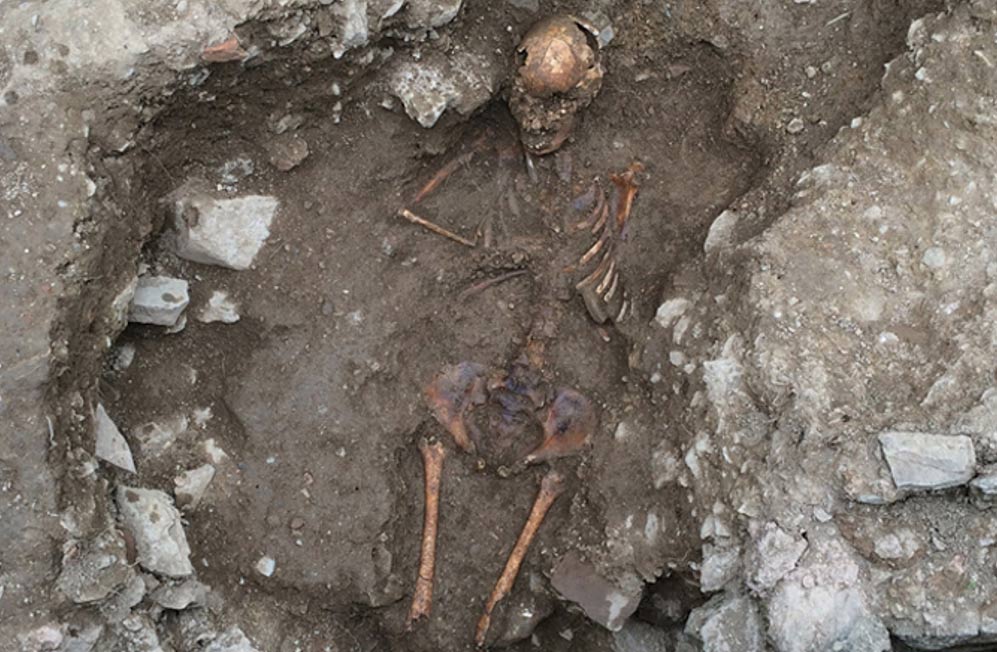Archaeologists find medieval teenage witch burial in Italian town
A 15- to 17-year-old girl was considered so dangerous to her medieval Italian community, even after death, that the villagers burned her, threw her in a pit and covered her remains with big stone slabs, archaeologists said. This is the second medieval “deviant burial” found in the town of Albenga.
It is unknown exactly when the girl was buried because researchers haven’t yet done carbon dating, but archaeologists estimate the girl died between the ninth and 15 th centuries AD, says an article in Discovery.
“We can’t say whether she was alive or not when she was burnt. Fire attacked her body when soft tissues were still present, so it could have occurred before death or soon after,” said anthropologist Elena Dellù, as quoted by Discovery News.
The girl was buried in the San Calocero complex in Albenga. The dig is being conducted by the Pontifical Institute of Archaeology at the Vatican.
In September 2014 the team found another “witch burial,” this one of a 13-year-old girl who was buried face down in a deep tomb. She is believed to have had scurvy that disfigured her body, causing her community to reject her, archaeologists concluded in May 2015.
Italian media outlets called her “the witch girl” after her skeleton was exhumed in September 2014, also from the San Calocero complex. Radiocarbon dating shows she died between 1400 and 1500 AD. She was found in the burial ground of a church built in the 5th and 6th centuries AD and then abandoned in 1593.
Face-down burials were carried out as an act of punishment intended to humiliate the dead, and discoveries like this are considered rare. In some cases, bodies have been found with a brick in their mouth or staked to the ground, decapitated or dismembered.

The town of Albenga is old, dating back to at least Roman times. This is the wall of a Roman tomb on the Via Julia Augusta. (Photo by Broenberr/Wikimedia Commons)
Analysis of the remains of the girl found most recently showed porous bone tissue on her skull and orbits, Discovery said. The spongy bone matter may have resulted from severe iron deficiency anemia. She also had weak enamel, which indicates possible childhood malnutrition. These conditions may have given her skin very light color and bruising, which possibly scared the people of her community.
The girl found in 2014 also had porosis of her skull and deformed bones and was diagnosed in 2015 with scurvy, though the bones in the recently discovered girl are damaged such that the researchers can’t make a definite diagnosis of scurvy for her.
The researchers said scurvy causes pale skin and possibly other symptoms, including bleeding from the eyes, legs and mouth; protruding eyes; frog-leg posture; epileptic seizures; and corkscrew hair. If the girls had all these symptoms, they may have been rejected and buried in what is called a deviant burial so their souls, which scholars speculate the community thought impure, could not rise to haunt living people.
A similar practice in the Middle Ages was linked with a belief in vampires, in which the deceased had a stone wedged in their mouth, or was even pinned to the ground with a stake. People believed this would prevent them from leaving at midnight and terrorizing the living. The legends formed an important part of folklore throughout Europe. In Bulgaria alone, more than 100 such ‘vampire’ burials have been found.
In Scotland in October 2014 archaeologists found what they believe is the grave of the last Scottish woman accused of being a witch. Following her death in prison, Lilias Adie was buried in deep mud with a heavy flat stone placed on top of her – a tradition based on the belief that witches could rise from their graves unless held down by a heavy stone.
Ancient Origins reported in April 2015 about a medieval or Saxon man whose skeleton was found in a Roman villa in Hampshire, England, who may have been buried in the countryside because of a jaw deformity that made his community consider him plagued by spirits. It’s also possible the community had earlier trepanned his skull to exorcise the evil spirits.

The trepanned skull of a medieval or Saxon man found in Hampshire. (Photo by Hampshire Archaeology)
The man with the deformed jaw, who died about age 35 to 45, had a missing right hand and missing foot bones, possibly a punishment or a result of desecration by grave robbers. His skull had been drilled, which also could have been to relieve effects of his jaw deformity.
Featured image; Italian archaeologists have unearthed the remains of a teenage girl given a “deviant burial” because she appeared different from and possibly scared her fellow villagers. (Discovery News photo)
By Mark Miller




















Comments
I enjoy finding out the history to present times of witches and witch craft. History's true stories . Probably my favorite is of Greek Myth's as well as Roman Myth's.
I enjoy finding out the history to present times of witches and witch craft. History's true stories . Probably my favorite is of Greek Myth's as well as Roman Myth's.